The White Swan Building: An Architectural Marvel in Dubai
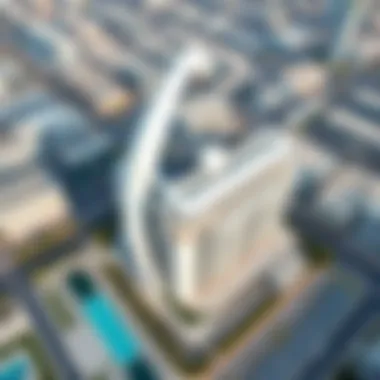

Intro
The White Swan Building stands as an emblem of progress within Dubai's ever-evolving skyline. Commissioned at a time when the emirate was diving deep into architectural ambition, this building is more than just a structure; it's a symbol of innovation and craftsmanship. The design intricacies reveal a dedication to not just aesthetics but also to functionality and sustainability.
This article aims to peel back the layers of the White Swan Building, exploring its conceptualization, structure, and the broader implications it has on the surrounding real estate landscape. The piece also shines a light on the intricate interplay between architecture and urban life, making it a vital case study for anyone interested in the dynamics of contemporary urban development. Through dissecting the key elements that make the White Swan so unique, readers will uncover a rich tapestry of insights that encompass not just design but its societal impact as well.
With many eyes turned towards this landmark, conversations around its value remain pertinent. Investors, expats, agents, buyers, and renters alike find themselves drawn to its significance in shaping property values and community structures. As we delve deeper, we will consider market trends, investment strategies, and the architect's vision that rendered this building a pivotal addition to Dubai's architectural narrative.
Understanding the White Swan Building is daunting at first glance, but stay tuned as we break it down and elucidate its status in the marketplace. The insights drawn will provide an evergreen reference for anyone examining the architectural scene in Dubai.
Market Trends
Current Market Analysis
Dubai's property market has undergone significant shifts in recent years. The White Swan Building, with its luxurious design and strategic location, reflects changing demands among both local and international investors. Recent data shows a growing interest in high-end residential properties amid rapid urbanization and heightened expatriate influx.
Across key districts in the emirate, property values have been fluctuating. The demand for unique architectural designs, such as the White Swan, indicates a willingness among buyers to invest in spaces that offer both luxury and a sense of community. This trend highlights a fundamental shift linking aesthetic appeal with market value. Investors are keeping a close eye on how distinctive buildings influence overall property trends.
In the context of the White Swan, the anticipation for such pioneering spaces is driving buyers to seek units before they even hit the market. With a notable demographic in flux, the demand appears unyielding, leaving nuances of pricing fluctuation dependent on location, design, and utility.
Future Projections
Looking ahead, projections reveal a steady growth in Dubai's property market, particularly for distinctive landmarks like the White Swan. Analysts foresee an uptick in property values, with estimates suggesting that prime properties may witness appreciation of up to 10-15% over the next few years. This expectation stems from several factors, including continued foreign investment, the city's flourishing tourism sector, and increased infrastructure development.
This optimism creates fertile ground for property investors. As developers seek to cater to both luxury segments and the burgeoning middle class, spots like the White Swan are bound to increasingly play a central role. The broader implications of these trends forge a path for the community layout, altering the living patterns in Dubai.
Intro to the White Swan Building
The White Swan Building stands as a testament to Dubai’s relentless pursuit of architectural brilliance and innovative design. Situated in the heart of the city, this structure is not just an addition to the skyline but an influential piece of urban fabric. The intricate layers of its design, functionality, and strategic location provide an example for future developments in the region. Understanding the significance of the White Swan Building is essential for anyone interested in modern architecture, urban development, and the economic implications of such endeavors.
Overview of Its Location
The White Swan Building is nestled in Downtown Dubai, a prestigious area known for its blend of luxury and tradition. This prime location is not merely a choice; it represents a strategic move to enhance connectivity to various parts of the city. Being close to art galleries, shopping districts, and cultural hubs positions it at the center of dynamic urban life. For investors, the allure of being in a high-traffic area promises substantial returns, while expats and buyers find a vibrant community pulsing with energy.
Some key aspects of its location include:
- Accessibility: The proximity to major highways and public transport ensures that both residents and visitors can navigate easily.
- Proximity to Landmarks: With attractions like the Burj Khalifa and Dubai Mall nearby, social and cultural experiences abound.
- Urban Planning: Downtown Dubai is engineered to foster community and social interaction, increasing the appeal for potential buyers and renters.
Inspiration Behind the Design
The design of the White Swan Building is an endeavor that fuses tradition with modernity, capturing the essence of Dubai’s rapid evolution. Its form echoes the elegance of a swan, symbolizing grace and beauty, which directly connects to the cultural tapestry of the region. This inspiration is drawn from local architecture, marrying classical elements with innovative materials that stand out yet do not overshadow their surroundings.
Several design influences include:
- Cultural Reflection: Features reminiscent of Islamic architecture, such as intricate geometric patterns, pay homage to the region's rich history.
- Sustainability: The design incorporates environmental considerations, focusing on energy efficiency without compromising aesthetics.
- Modernist Elements: Clean lines and expansive glass facades embody a contemporary approach, aligning with global architectural trends that prioritize light and space.
"The blending of traditional aesthetics with modern functionality creates a living artifact that tells a story of Dubai’s growth and vision."
Through understanding the foundational elements of the White Swan Building, one gains insight into the broader narrative of Dubai's architectural landscape and its evolving identity. This building encapsulates a meticulous balance of innovation and cultural homage, marking it as a significant player in the ongoing tale of urban development in Dubai.
Architectural Significance
The architectural significance of the White Swan Building is not just about its physical presence on the Dubai skyline; it's a multifaceted exploration of design, innovation, and cultural resonance. As Dubai evolves into a global metropolis, this building stands as a testament to the ambitious vision of its architects and stakeholders. It is crucial to examine the specific elements that make this edifice noteworthy. Through a blend of aesthetic appeal and functional design, the White Swan offers a unique architectural language that reflects both modernity and tradition, creating a rich tapestry of meaning.
Design Features and Aesthetics
The design features of the White Swan Building are a blend of the contemporary and the timeless. Its sleek, flowing lines evoke the image of a swan gliding on water, aiming to create a sense of serenity amidst the bustling urban environment. The facade is a kaleidoscope of glass and steel, which not only enhances its visual appeal but also reflects the ever-changing colors of the sky.
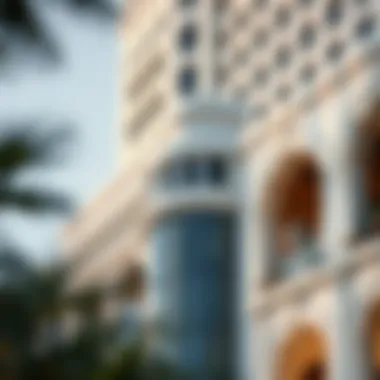
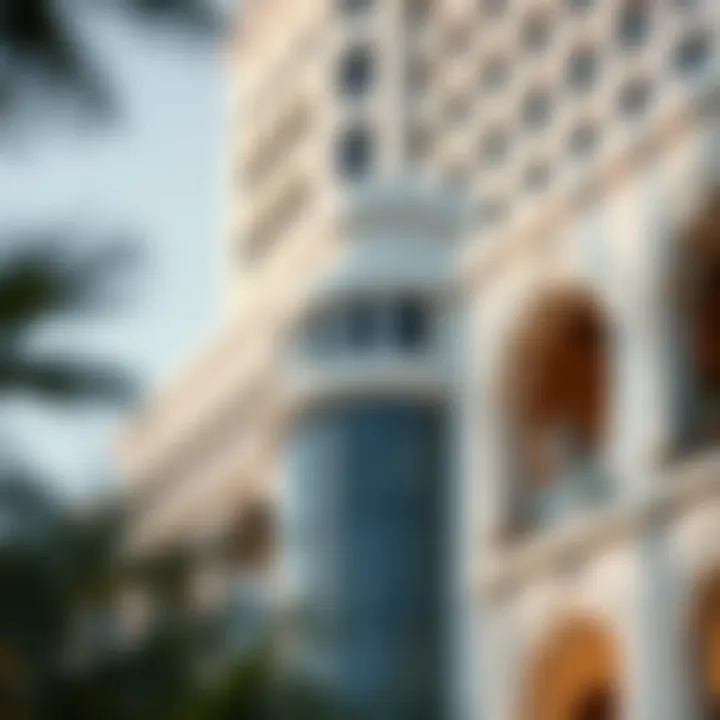
Incorporating biophilic design principles, the structure includes green terraces and living walls that bring nature into the urban space, fostering a connection with the environment. Features such as these contribute to a sense of well-being among residents and visitors alike, aligning with the aims of modern architecture to enhance not just aesthetics, but experience.
The lobby offers a grand entrance, welcoming guests with high ceilings adorned with artistic elements inspired by traditional Emirati motifs. This thoughtful integration of local culture into the design creates a narrative that honors the past while embracing the future. The interplay of light and shadow through the building’s innovative use of glass adds an additional layer of beauty, creating an ever-evolving scenery depending on the time of day.
The Role of Innovative Materials
In today's architecture, the choice of materials can significantly influence both the performance and aesthetics of a building. The White Swan Building utilizes cutting-edge materials such as high-performance glass, which is not only energy-efficient but also plays a crucial role in thermal comfort. This innovation reduces the energy consumption typical in high-rise structures, making a compelling case for environmental stewardship in modern architecture.
Furthermore, the building employs lightweight composite materials that reduce the overall structural load. This means that the foundation can be less extensive, allowing for more efficient land use in a densely populated urban setting.
One key element is the use of recycled materials in construction, aligning the project with sustainability practices. Using locally sourced materials not only minimizes transport-related carbon emissions but also supports local economies, creating a win-win situation for the community.
As Dubai continues to position itself as a leader in sustainable urban development, the materials used in the White Swan Building serve as an example for future projects, offering investors tangible evidence of innovation paving the way for responsible architecture in the region.
"The White Swan Building is a reflection of Dubai's ambitions, balancing aesthetic beauty with functional performance through its ingenious use of modern materials."
Structural Engineering Aspects
Structural engineering plays a crucial role in shaping not just buildings, but also the very skyline of a city. For the White Swan Building, the aspects of structural engineering enhance its allure and functionality, ensuring the edifice can withstand both the test of time and the natural elements present in Dubai. The significance of structural considerations cannot be overstated; they intertwine safety, aesthetics, and sustainability into a cohesive whole.
A well-designed structure requires a solid foundation and efficient frameworks, which directly contribute to the building's longevity and safety during substantial loads and potential seismic events. This is particularly essential in a city like Dubai, where rapid urbanization is common.
Foundation and Framework
The foundation of the White Swan Building is a marvel in its own right. It employs deep piles, which anchor the structure firmly into the ground, ensuring stability in the shifting sands typical of Dubai’s geography. This foundational choice minimizes the risk of settlement issues, which is a constant worry in areas with loose soil.
- Benefits of Deep Foundations:
- Increased stability against lateral forces.
- Enhanced load-bearing capacity.
- Decreased risk of structural damages over time.
Moving upwards, the building's framework utilizes a combination of reinforced concrete and steel. This hybrid approach allows the building to rise taller while maintaining flexibility and strength. The strategic placement of columns and beams not only enhances the structural integrity but also contributes to the unique aesthetics of the White Swan Building. In essence, it’s a dance between form and function, where every element has a purpose.
"In structural engineering, every choice made is a step towards either longevity or decay. The foundation sets the tone for what's to come."
Integration of Technology in Construction
Modern construction techniques and technologies have revolutionized the way buildings are erected, and the White Swan Building showcases this evolution beautifully. The integration of Building Information Modeling (BIM) allowed architects and engineers to visualize every aspect of the building before even breaking ground.
- Advantages of BIM:
- Improved collaboration among design teams.
- Early identification of design flaws.
- Streamlined project management and cost estimation.
Apart from BIM, the White Swan Building also uses high-tech sensors embedded within its structures. These sensors monitor the health of the building continuously, tracking vibrations and other physical parameters that could indicate stress or potential failure. This proactive approach ensures maintenance is timely, keeping both safety and investment in mind.
The use of advanced materials such as high-performance concrete, coupled with efficient construction methods, aligns perfectly with Dubai’s vision for sustainable urban development.
Impact on the Real Estate Market
The White Swan Building isn’t just a pretty face gracing the Dubai skyline; it’s also a critical player in the city's ever-evolving real estate landscape. Understanding its impact goes deeper than surface aesthetics; it's about how it reshapes property values, influences community structures, and introduces new dynamics in investment.
Property Value Assessment
Assessing the property value surrounding the White Swan is akin to taking the temperature on a rollercoaster. Significant developments often ripple through their locales, and this building is no exception. When you look beyond the building itself, you can see that it engenders a synergistic effect on nearby properties. For instance, real estate in the vicinity often experiences a spike in demand owing to the architectural prestige that the White Swan represents.
This phenomenon isn’t merely a matter of perception; it’s reflected in hard numbers. The average property value in areas neighboring the White Swan has shown consistent upward trends. This spike can directly correlate to factors such as increased desirability for both residential and commercial spaces. Investors are keenly aware of this; they know that a high-profile building can elevate an entire neighborhood’s appeal, which often translates to higher rental yields and margins on resale.
- Enhanced Marketability: Properties near the building acquire an edge in marketing due to the upscale image it projects.
- Increased Demand: The area often experiences a surge in inquiries from potential buyers and renters alike, just due to the prestige associated with the White Swan.
- Investment Confidence: A solid infrastructure typically boosts investor confidence, encouraging more capital to flow into surrounding areas.
Commercial Viability and Investment Potential
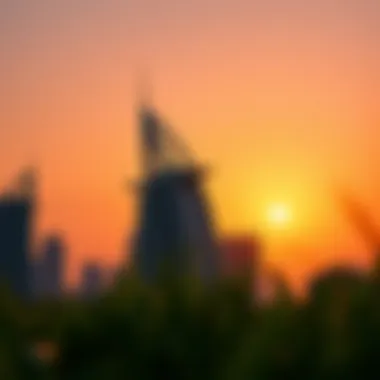

From an investment standpoint, the White Swan Building shines like a beacon for both domestic and international investors. Its commercial spaces are highly sought after, drawing businesses ranging from luxury boutiques to high-end restaurants. This demand has prompted a rethink of how businesses view location strategy in Dubai. The architects and developers of the White Swan have brilliantly tapped into the pulse of modern consumerism, where an architectural landmark can serve as a magnet for high-net-worth clientele.
Real estate professionals often highlight that commercial viability extends far beyond just leasing space. It involves creating a vibrant ecosystem where businesses can thrive, and the White Swan is a quintessential example of this.
- Strong Occupancy Rates: Commercial outlets in the building maintain impressive occupancy rates compared to other regions, thanks to its strategic appeal and consistent foot traffic.
- Diverse Investment Options: From retail spaces to office facilities, the building offers a variety of options, catering to different business needs.
- Future-Proofing Investments: With a focus on sustainable practices and technology integration, the building aligns itself with future market demands, appealing to investors wary of obsolescence.
The White Swan isn’t merely a feature of Dubai’s skyline; it’s a catalyst for growth. Its influence on the real estate market leaves a lasting imprint, and as urban spaces continue to evolve, the insights derived from its development could serve as a template for future architectural projects in the region.
"The White Swan's impact on surrounding property values is a testament to the idea that iconic structures don't just beautify, they actively shape economic realities."
Understanding these complexities isn’t just for investors; it's for anyone involved in real estate in Dubai. Whether you’re looking to rent, buy, or simply appreciate the architectural landscape, the White Swan plays a pivotal role in the ongoing story of urban development.
Community and Lifestyle Influences
The White Swan Building isn’t just a structure; it symbolizes a nexus where community and lifestyle converge in Dubai. The architectural endeavor represents how modern design impacts daily life and urban interactions, emphasizing the essence of connectivity in a bustling metropolis.
Enhancing Urban Connectivity
In the fast-paced urban environment of Dubai, the White Swan Building plays a crucial role in improving urban connectivity. The design incorporates pedestrian-friendly pathways, allowing residents and visitors to seamlessly traverse the area. This is particularly important in a city where traffic can sometimes feel like an endless snake, coiling and twisting without much progress.
Enhancing connectivity isn’t only about roads and transportation; it’s also about creating spaces that encourage social interactions and community engagement.
The building's strategic placement in proximity to vital transport hubs, such as the Dubai Metro and major highways, fosters accessibility. People can easily get from point A to point B without the headache of long travel times. Furthermore, its close ties with retail and recreational spaces create vibrant hubs where people can gather, socialize, and relax. This integration allows a sense of belonging, turning the communal experience into something meaningful.
Cultural and Social Contributions
Beyond just practicality, the White Swan Building embodies the cultural fabric of Dubai. It acts as a canvas for cultural expression, with art installations and public spaces designed for local artists and performers. These initiatives invigorate the area, allowing traditional and contemporary art forms to blend beautifully, appealing to both locals and expats alike.
From facilitating community events to showcasing local talent, the building adds layers of social interaction. It’s not uncommon to find weekend markets or cultural festivals held in and around the premises, drawing families and individuals from diverse backgrounds.
Moreover, the building encourages an appreciation for sustainability. Educational initiatives within its walls highlight environmental awareness and community stewardship, promoting a lifestyle that respects both culture and nature.
In essence, the White Swan Building is more than bricks and mortar. It stands as a beacon of how architecture can shape and enrich urban life. Its influence reaches into the community, enhancing connectivity and contributing to the social and cultural landscape of Dubai, ultimately making it a cornerstone for fostering a collectively rich urban experience.
Sustainability Considerations
As the world grapples with climate change and resource depletion, the Sustainability Considerations surrounding architectural projects have gained unprecedented importance. In Dubai, a city known for towering skyscrapers and relentless urban expansion, the White Swan Building stands out as a beacon of sustainable design and construction. Aiming for a minimal environmental footprint while blending seamlessly into the urban landscape, the White Swan incorporates innovative strategies that positively impact energy consumption, environmental preservation, and community well-being.
The implementation of sustainable practices is not merely a compliance measure; it is a forward-thinking approach aligned with global environmental goals. For investors and property buyers, these elements not only enhance the building's marketability but also contribute to a growing societal demand for eco-friendly living spaces.
Energy Efficiency Innovations
One of the most notable achievements of the White Swan Building lies in its energy efficiency innovations. The architectural design integrates state-of-the-art technologies aimed at reducing energy consumption dramatically.
- Smart Building Management Systems: These systems monitor and adjust lighting, heating, and cooling based on real-time occupancy and environmental conditions. By optimizing energy use, the building can reduce its energy costs and carbon footprint significantly.
- High-Performance Glazing: The windows feature specialized glazing designed to minimize heat gain while allowing natural light to permeate the space. This balance not only enhances occupant comfort but reduces reliance on artificial lighting and air conditioning.
- Solar Energy Utilization: Solar panels installed on the roof and strategic locations around the property harness renewable energy. This integration contributes to the building's energy needs and promotes a sustainable lifestyle for its residents.
These innovations showcase how the White Swan Building is not just a structure but a responsible entity contributing to a greener future.
Environmental Impact and Mitigation Strategies
The environmental impact of any construction project is a major concern, and the White Swan Building addresses this head-on through robust mitigation strategies.
- Water Conservation Technologies: The building employs water-efficient fixtures and rainwater harvesting systems, drastically reducing water consumption per occupant. Such systems ensure that water conservation becomes a part of everyday living.
- Waste Management Protocols: Construction debris was meticulously sorted and recycled to divert a significant volume from landfills. Ongoing waste management for the building’s operations includes composting organic waste and recycling materials, fostering a culture of sustainability among occupants and management.
- Biodiversity Support: Landscaping initiatives prioritize native and drought-resistant plant species, creating habitats that support local wildlife while minimizing irrigation needs. This not only enriches the aesthetic value of the building but enhances biodiversity in an urban environment.
"Sustainability is no longer about doing less harm. It's about doing more good." – Jochen Zeitz
For further insights on sustainable architecture, readers can refer to resources such as Wikipedia and Britannica.
Let’s cherish and nurture the balance between urban growth and environmental stewardship.
Comparative Case Studies
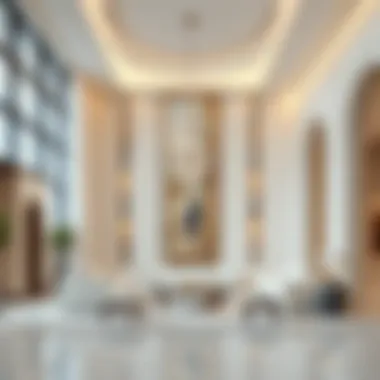
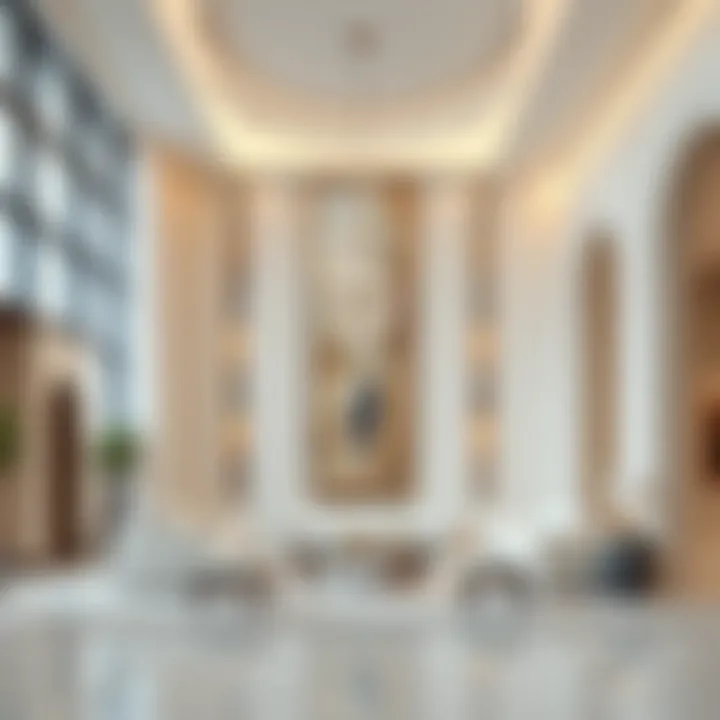
The exploration of comparative case studies serves as a pivotal element in understanding the White Swan Building's architectural narrative. By examining similar structures both locally and globally, one can glean valuable insights into design philosophies and urban development trends that resonates within Dubai's eclectic skyline. These comparisons are not merely academic; they provide a lens through which investors, expats, agents, buyers, and renters can assess value, functionality, and aesthetic allure. Here, we delve into two distinct yet relevant subsections that highlight the White Swan's unique standing amidst architectural contemporaries.
Similar Iconic Buildings in Dubai
When discussing iconic structures in Dubai, it’s impossible not to mention the Burj Khalifa, standing tall as the world’s tallest building, or the Burj Al Arab, with its sail-like silhouette. Both these landmarks set the stage for a vibrant architectural dialogue within the city. The White Swan Building, while distinct in its aesthetic, holds its own in this landscape by adopting a different yet equally visionary approach.
- Burj Khalifa: Known for its soaring height and luxury residences, it showcases advanced engineering techniques which have become a hallmark of Dubai's architectural epiphany.
- Burj Al Arab: This structure emphasizes opulence and exclusivity, presenting a beacon of luxury hospitality that attracts visitors from across the globe.
The White Swan, however, carves a niche that blends functionality with elegance. Its design ethos focuses on sustainability, promoting a harmonious coexistence between modern living and environmental consciousness. The juxtaposition of these structures signifies a broader trend within Dubai, where innovation meets the practical needs of urban life. Aspects like the incorporation of local culture into design, use of innovative materials, and eco-friendly strategies further bolster the appeal of the White Swan, setting a precedent for future architectural endeavors within the region.
Global Architectural Parallels
Stepping outside the borders of Dubai, the White Swan Building finds parallels in other pioneering structures worldwide. While the architectural styles may differ, the thematic connections underscore global trends in urban design, sustainability, and the pursuit of aesthetic excellence.
- The Shard in London: This structure redefines the skyline of the UK capital with its sharp, glass façade. Much like the White Swan, it emphasizes transparency and light, creating an inviting environment for its occupants.
- The Sydney Opera House: Known for its distinct sail-like roof, this landmark not only represents a feat of ingenuity but also integrates seamlessly with its waterfront environment, akin to how the White Swan interacts with Dubai's urban fabric.
- Torre Agbar in Barcelona: Featuring a bullet-shaped design and dynamic lighting, this building is a testament to modernity, paralleling the White Swan's commitment to innovative aesthetics.
Each of these structures shares a core philosophy: they aspire to challenge conventional design norms while addressing the cultural and environmental contexts of their respective locales. As Dubai progresses, the White Swan Building stands poised to inspire similar future developments, promoting not only an aesthetic vision but also a deeper commitment to sustainability and community integrations.
"The architecture of the future must reflect the values of the present, bringing together creativity and responsibility in equal measure."
In summary, through comparative case studies, the White Swan Building emerges not merely as an isolated achievement but as a significant player in a broader dialogue about architectural innovation and urban living. By drawing parallels with both local icons and global masterpieces, one can appreciate the unique contributions and the future potential of this remarkable structure in shaping the urban narrative of Dubai.
Future Projections
The future of urban development is a hot topic, especially in a rapidly growing city like Dubai. The White Swan Building stands as a testament to this evolution. It showcases not just architectural beauty but also the shifting paradigms of urban structures. As cities worldwide confront increasing population densities, it becomes essential to analyze how buildings like the White Swan can impact future trends.
Trends in Urban Development
Urban growth is a force to be reckoned with. Consider the fact that more than 50% of the world's population now resides in urban areas, a figure projected to climb to nearly 70% by 2050.
- Smart Cities: Future developments will likely see a surge in smart city initiatives. Buildings like the White Swan can lead the way by integrating technology into their infrastructure—creating ecosystems where sustainability and connectivity go hand in hand.
- Mixed-Use Developments: There’s a growing preference for properties that offer both living and working spaces. This trend can drive demand for buildings designed with flexibility in mind. The White Swan's design reflects this, supporting residential, commercial, and recreational purposes within its footprint.
- Public Spaces: Future projects may increasingly focus on creating public and green spaces. The White Swan could inspire similar initiatives, allowing for a harmonious balance between urban living and nature.
These trends are not just theoretical; they represent a vision of what a thriving urban area can look like. By embracing these elements, developers can help cities evolve in ways that enrich the quality of life for residents.
The Role of Technology in Future Projects
Technology will undoubtedly play a crucial role in shaping the skyline of tomorrow. The White Swan Building's innovative use of materials and design principles serves as a model for future endeavors.
- Building Information Modeling (BIM): Effective planning starts with technology. BIM allows architects and engineers to visualize a building before it even breaks ground, reducing errors and costs. Future projects could integrate this technology not only in design but also throughout the construction lifecycle.
- Automated Systems: Smart systems that monitor energy use, heating, lighting, and water consumption can drastically improve efficiency. By embedding these systems, buildings can operate sustainably.
- Virtual Reality (VR) and Augmented Reality (AR): Immersive technologies could transform the buyer’s journey, allowing potential investors and occupants to explore spaces before they exist. This kind of engagement could become standard practice in the future, much like how the White Swan utilizes modern design.
By keeping an eye on emerging technology, Dubai can remain at the forefront of urban innovation, ensuring its developments align with future demands and environmental responsibilities.
The future of urban environments, reflected in projects like the White Swan Building, encapsulates the immense possibilities that lie ahead. From smart technology to comprehensive urban planning, the horizon appears bright for investors, homebuyers, and the landscape of Dubai itself.
Closure
The examination of the White Swan Building is not just an exploration into a singular architectural achievement; it poses significant implications on multiple facets of Dubai's evolving urban landscape. The concluding section of this article serves to encapsulate the key takeaways from the previous discussions, emphasizing the importance of understanding both the immediate and broader implications of such structural creations.
Summarizing Key Insights
Throughout this piece, we have uncovered various layers of significance within the White Swan Building.
- Location and Accessibility: The strategic positioning of the building enhances not just its appeal but also the urban fabric of Dubai.
- Architectural Innovation: The sophisticated design and use of modern materials set it apart from other structures in the vicinity, showcasing a blend of aesthetic and functional design.
- Economic Impact: Its presence contributes positively to property valuations in the surrounding areas, demonstrating a sustainable model for future developments.
- Community Integration: The project showcases an emphasis on cultural integration and social interaction, fostering a sense of community within the burgeoning metropolis.
- Environmental Responsiveness: The sustainable initiatives incorporated into its design reflect a growing awareness of ecological responsibility within urban planning.
Each of these points contributes to a heightened understanding of the intricate relationships between architecture, economics, and community life in urban settings, particularly in a city like Dubai, where the skyline is constantly evolving. As the dynamics of urban development change, the lessons learned from the White Swan Building stand as a testament to forward-thinking approaches in architectural and urban planning.
Final Thoughts on the White Swan Building
As we reflect on the White Swan Building's significance, it's essential to consider its multifaceted role in shaping Dubai's urban narrative. This building is more than just concrete and glass; it’s a symbol of progress—a marker that paves the way for future developments in the region. For investors, a keen understanding of such architectural landmarks can translate into lucrative opportunities. Expatriates searching for residences in urban areas will find the building's offerings appealing, while agents and buyers can utilize its prestige as a compelling selling point.
Ultimately, the White Swan Building encapsulates the spirit of innovation and sustainability that is becoming synonymous with Dubai's global presence. As urban centers continue to grow, the principles exemplified by this building will surely guide forthcoming projects, ensuring that the next architectural endeavors not only meet the demands of modernity but also contribute to the broader social and environmental contexts.
“Investing in unique architecture often reflects the trends of urban evolution—embracing sustainability and community at its core.”
By understanding the nuances involved in the White Swan Building, one gains invaluable insights into the future of real-estate market trajectories and urban development strategies in Dubai and beyond. This coherent relationship between structure, community, and environment will be instrumental in shaping the narrative for generations to come.

